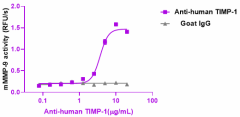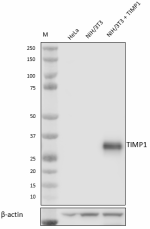- Clone
- Poly5296 (See other available formats)
- Regulatory Status
- RUO
- Other Names
- Erythroid-potentiating activity (EPA), Fibroblast collagenase inhibitor, Tissue inhibitor of metalloproteinases 1 (TIMP1), TIMP Metallopeptidase Inhibitor 1, Erythroid-potentiating activity (EPA), Fibroblast collagenase inhibitor
- Isotype
- Goat Polyclonal IgG
- Ave. Rating
- Submit a Review
- Product Citations
- publications

-

LEAF™ purified ant-human TIMP-1 (Poly5296) (purple squares) recovered the activity of recombinant mouse MMP-9 (Cat. No. 755204) in a dose-dependent manner which was inhibited in the presence of recombinant human TIMP-1 (Cat. No. 592404) at 0.33 µg/mL, whereas the LEAF™ purified goat IgG isotype control (gray triangles) does not have the effect. ND50 range: 0.4 – 4 µg/mL. -

IHC staining of LEAF™ purified anti-human TIMP-1 (clone Poly5296) on formalin-fixed paraffin-embedded human pancreas tissue. Following antigen retrieval using 1X Citrate Buffer (Cat. No. 420902), the tissue was incubated without (panel A) and with (panel B) 1.0 µg/mL of the primary antibody overnight at 4°C. BioLegend’s Ultra Streptavidin HRP Kit (Multi-Species, DAB) (Cat. No. 929501) was used for detection followed by hematoxylin counterstaining, according to the protocol provided. The image was captured with a 40X objective. Scale bar: 50 µm. -

Whole cell extracts (15 µg total protein) from HeLa, and NIH/3T3 spiked with or without the indicated amount of recombinant human TIMP-1 protein (Cat. No. 592404) were resolved on a 4-12% Bis-Tris gel electrophoresis, transferred to a PVDF membrane, and probed with 0.25 µg/mL LEAF™ Purified anti-human TIMP-1 (clone Poly5296) overnight at 4°C. Proteins were visualized by chemiluminescence detection using HRP donkey anti-goat IgG at a 1:10000 dilution. Direct-Blot™ HRP anti-β-actin (Cat. No. 643807) was used as a loading control at a 1:10000 dilution. Western-Ready™ ECL Substrate Premium Kit (Cat. No. 426319) was used as a detection agent. Lane M: Molecular weight marker.
TIMPs (tissue inhibitors of metalloproteinases) are endogenous inhibitors for MMPs (matrix metalloproteinases). The TIMPs consist of structurally and functionally distinct N- and C-terminal domains, each of which is stabilized by three disulfide bonds. The N-terminal domain binds to the active site of MMPs, inhibiting their proteolytic activities. The bidentate coordination of the zinc ion in the active site of an MMP by the N-terminal α-amino group and carbonyl group of the Cys residue in the "cysteine switch" is a key mechanism of inhibition with MMPs. The TIMP's C-terminal domain is known to bind hemopexin-like domain of pro-MMPs. TIMPs are broad-spectrum inhibitors of MMPs, but there are some differences in specificity among them. Mouse metalloproteinase inhibitor 1, TIMP-1, is more restricted in its inhibitory range than the other three TIMPs, having a relatively low affinity for the membrane-type MMPs, MMP-14, MMP-16, and MMP-24 as well as for MMP-19. Mouse TIMP-1 shares a 72% homology with its human counterpart. It is widely expressed in many mammalian tissues, notably in the reproductive organs. TIMP-1 is able to promote cell proliferation in a wide range of cell types and may also have an anti-apoptotic function. It has anti-angiogenic activity by preventing endothelial cell migration. CD63 has been identified as a receptor for TIMP-1. TIMP-1 binding to CD63 inhibits apoptosis and arrests cell growth. TIMP-1-null mice exhibit a number of alterations in processes associated with reproduction, steroidogenesis and impaired learning and memory. In addition, mice deficient in TIMP-1 exhibit enhanced MMP activity that would contribute to a reduction of atherosclerotic plaque size; nevertheless, it promotes aneurysm formation.
Product DetailsProduct Details
- Verified Reactivity
- Human
- Antibody Type
- Polyclonal
- Host Species
- Goat
- Immunogen
- Recombinant human TIMP-1
- Formulation
- 0.2 µm filtered in phosphate-buffered solution, pH 7.2, containing no preservative.
- Endotoxin Level
- Less than 0.1 EU/µg of the protein (< 0.01 ng/µg of the protein) as determined by the LAL test.
- Preparation
- The LEAF™ (Low Endotoxin, Azide-Free) antibody was purified by affinity chromatography.
- Concentration
- The antibody is bottled at the concentration indicated on the vial. To obtain lot-specific concentration and expiration, please enter the lot number in our Certificate of Analysis online tool.
- Storage & Handling
- Upon receipt, store frozen at -20°C. Make small volume aliquots if needed and avoid repeated freeze-thaw cycles to prevent denaturing the antibody.
- Application
-
Neut - Quality tested
IHC-P, WB - Verified - Recommended Usage
-
Each lot of this antibody is quality control tested by recovering the activity of recombinant mouse MMP-9 (Cat. No. 755204) that was inhibited in the presence of recombinant human TIMP-1 at 0.33 µg/mL (Cat. No. 592404). ND50 range: 0.4 – 4 μg/mL. For immunohistochemistry on formalin-fixed paraffin-embedded tissue sections, a concentration range of 1.0 - 10.0 µg/mL is suggested. For western blotting, the suggested use of this reagent is 0.125 - 1.0 µg/mL. It is recommended that the reagent be titrated for optimal performance for each application.
- RRID
-
AB_2941598 (BioLegend Cat. No. 529603)
Antigen Details
- Structure
- Monomer
- Distribution
-
It is widely expressed in mammalian tissues, notably in reproductive organs and skin
- Function
- Angiogenesis, tissue remodeling, cancer metastasis, apoptosis
- Interaction
- Hematopoietic stem and progenitor cells, CD63 positive cells
- Ligand/Receptor
- CD63, MMPs, pro-MMP-9
- Biology Area
- Angiogenesis, Apoptosis/Tumor Suppressors/Cell Death, Cell Adhesion, Cell Biology, Cell Death, Stem Cells
- Molecular Family
- Enzymes and Regulators
- Antigen References
-
- Brew K and Nagase H. 2010. Biochim Biophys Acta. 1803:55-71.
- Murphy G. 2011. Genome Biol. 12:233
- Bourboulia D and Stetler-Stevenson WG. 2010. Semin Cancer Biol. 20:161-8.
- Kim YS, et al. 2012. BMB Rep. 45:623-8.
- Gene ID
- 7076 View all products for this Gene ID
- UniProt
- View information about TIMP-1 on UniProt.org
Related FAQs
- Do you guarantee that your antibodies are totally pathogen free?
-
BioLegend does not test for pathogens in-house aside from the GoInVivo™ product line. However, upon request, this can be tested on a custom basis with an outside, independent laboratory.
- Does BioLegend test each Ultra-LEAF™ antibody by functional assay?
-
No, BioLegend does not test Ultra-LEAF™ antibodies by functional assays unless otherwise indicated. Due to the possible complexities and variations of uses of biofunctional antibodies in different assays and because of the large product portfolio, BioLegend does not currently perform functional assays as a routine QC for the antibodies. However, we do provide references in which the antibodies were used for functional assays and we do perform QC to verify the specificity and quality of the antibody based on our strict specification criteria.
- Does BioLegend test each Ultra-LEAF™ antibody for potential pathogens?
-
No, BioLegend does not test for pathogens in-house unless otherwise indicated. However, we can recommend an outside vendor to perform this testing as needed.
- Have you tested this Ultra-LEAF™ antibody for in vivo or in vitro applications?
-
We don't test our antibodies for in vivo or in vitro applications unless otherwise indicated. Depending on the product, the TDS may describe literature supporting usage of a particular product for bioassay. It may be best to further consult the literature to find clone specific information.
Other Formats
View All TIMP-1 Reagents Request Custom Conjugation| Description | Clone | Applications |
|---|---|---|
| LEAF™ Purified anti-human TIMP-1 | Poly5296 | Neut,IHC-P,WB |
Compare Data Across All Formats
This data display is provided for general comparisons between formats.
Your actual data may vary due to variations in samples, target cells, instruments and their settings, staining conditions, and other factors.
If you need assistance with selecting the best format contact our expert technical support team.













Follow Us